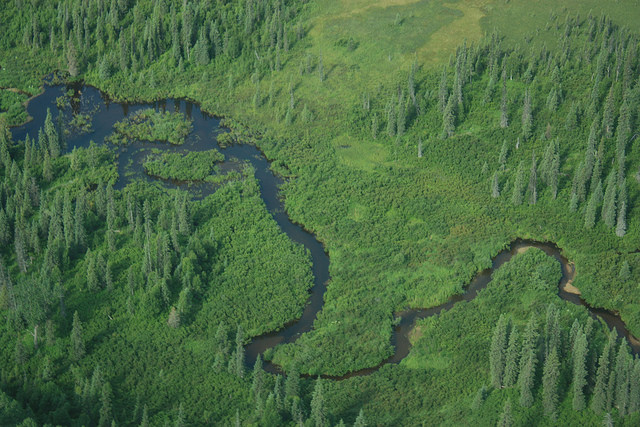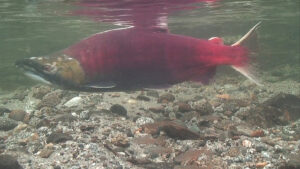
Water for Salmon, Not Coal
Middle Creek, an important salmon spawning tributary of the Chuitna River in Upper Cook Inlet, lies in the middle of where PacRim Coal wants to build a coal strip mine. The proposed plans include mining through and destroying nearly 14 miles of a wild salmon stream. Coal from the mine, owned by wealthy Texans, would be shipped to China and other Asian markets.

Aerial photo of Middle Creek, a tributary of the Chuitna River which PacRim plans to completely destroy to extract coal. Photo courtesy of Alaskans First.
Securing water for salmon in Middle Creek began in 2009 when Chuitna Citizens Coalition, represented by Trustees for Alaska, originally applied for a legal water right to keep water instream for salmon. Six years later the State of Alaska has announced a 15-day comment period (now extended by a month) to determine whether the State should grant Chuitna Citizens’ request for an instream reservation of water in this important creek. Unlike water rights that allow one to withdraw water, a reservation keeps water in the stream. In this case, Chuitna Citizens want enough water reserved to protect healthy salmon runs.
Six Years in the Making
Getting to this point—where the State is finally taking public comment on the application—has been no easy feat. After years of delay, Trustees attorneys went to court to force the State to respond to the application. After winning that lawsuit, the State began reviewing the application. This has required months of work with scientific experts retained by Chuitna Citizens to define how much water is necessary to protect salmon.
We are nearing the end of a drawn-out six year process to secure this water right. If the State approves the reservation, Chuitna Citizens will have a legally secured right that ensures water remains in Middle Creek for salmon. This would also mark the first time that the State has ever processed a water reservation application by a citizens group.
“The state of Alaska has a very simple choice to make between keeping water in streams for salmon or giving 100 percent of it to an Outside coal company to export coal to China,” said Judy Heilman, president and founding member of the Chuitna Citizens Coalition. “This application is a great opportunity for the Walker/Mallott Administration to stand with Alaskans and put fish first.”
Protections for Water
Alaska’s Constitution has some of the strongest language in the nation, recognizing the importance of fish and wildlife and water for Alaska’s people, and protecting the sustainable use of fish and water. The Alaska Water Use Act, passed in 1980, regulates water use applications. It allows anyone to apply for a water right to protect fish habitat, or to protect public drinking water, transportation, or recreation.
Water reservations are an important tool to avoid the over-appropriation of water and loss of fish habitat that has happened in other states. This precedent-setting decision is a critical step forward in protecting fish habitat throughout Alaska under our current system of water rights.
PacRim’s plan includes mining through and destroying 14 miles of salmon stream to get to the coal seam. One clear impact of such mining is the need to remove 100% of the water in Middle Creek. This application is about whether we preserve water for fish or allow a coal company to remove all the water so it can extract coal. How the Department of Natural Resources (DNR) responds will be precedent-setting, establishing whether DNR stands with the values of everyday Alaskans to protect our natural and renewable resources or with Outside companies seeking to make a profit at the expense and destruction of our resources.
Keeping water in streams for salmon is good for subsistence, recreation, the commercial fishing industry, our economy, and our way of life in Alaska. Please help us protect this stream by supporting Chuitna Citizens’ request for an instream reservation of water for Middle Creek. Add your voice to the comments currently being accepted by DNR.
You can submit comments online here.
Comments are due by 5:00 p.m. April 9, 2015.
More Information:
DNR’s Public Notice for Comment
Alaska Superior Court’s Decision Forcing DNR to Respond to the Application:
P1-17 Summary Judgement; P18-34 Summary Judgement; P35-51 Summary Judgement
Chuitna Citizen’s Council’s Press Release
Read All Our Stories on Chuitna
Meet Judy Heilman of the Chuitna Citizens Council and learn why she thinks its wrong to mine through a salmon stream.
Peninsula Clarion Story: Water rights Dispute Generates Thousands of Comments



